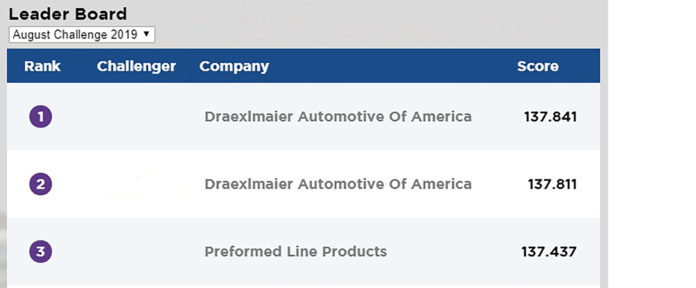by Dianna Brodine, managing editor,
Plastics Business
In the late 1970s, a televised sports program began with announcer Jim McKay’s voice saying, “The thrill of victory, and the agony of defeat.” The competitive spirit drives many to push a little harder, learn a little more and give additional effort. That’s the idea behind the monthly injection molding challenges issued by Paulson Training Programs.
The challenge
The 2019 SimTech™ Injection Molding Challenge launched in February as a series of free monthly challenges to test participants’ knowledge of injection molding. There are more than 400 active challengers, and the Top 30 are shown on the leaderboard on the Paulson Training website, providing added incentive to perform well. At the end of the year, a grand prize winner will receive $3,000 worth of training from Paulson Training Programs.
Each month, participants are given a challenge related to making a defect-free part, within specifications, with the fastest cycle time. The molding simulation uses defined parts to control the scenario, so all participants are solving the same problem.
The science
Michelle Paulson, director of marketing communications for Paulson Training Programs, explained the history behind the program. “Simtech was developed years ago when Chuck Paulson, an artificial intelligence programmer, took the research and knowledge that Don Paulson had accumulated over his plastics processing career and built a software engine to house all that information,” she said.
The simulation program has the ability to process more than 26 million calculations, and it helps plastics engineers develop a deeper understanding of the molding process.
Karen Paulson, president of the company, added, “It is based on physics and formulas. Plastic responds to only four variables: heat, flow, pressure and cooling, and it doesn’t know what kind of machine it’s in. Based on these physical laws, we can calculate what will happen to a plastic part. SimTech mimics a fully functioning molding machine so people can change controls and parameters to see what the outputs will be.”
SimTech is not a virtual prototyping tool – instead, it functions as a learning tool. “In any company, when people are learning, the most expensive way to learn is on a molding machine,” said Karen Paulson. “Simtech removes the cost of on-press learning.”
The reward
According to Michelle Paulson, the goal of the challenge is to teach processors, engineers and technicians the mindset with which to approach a problem. “We’re trying to educate people on the best way to approach making their parts. The challenge hits that concept home in a fun and engaging way,” she said. “When molding a part, the conditions and variables can change often. One set of rules won’t solve every problem.”
Karen Paulson added, “What worked last week on a machine is not necessarily going to work this week. We’re trying to teach them to think – what’s behind the problem? Then it doesn’t matter what machine they’re on, they have the tools to adjust machine controls to fix the problem.”
Peter Fongemie, lead process technician for Dymotek (Ellington, Connecticut), said the challenge reinforces the concepts he shares with his technicians. “What I try to teach is that it’s important to think about the process move – make one process move and see where that takes you, instead of changing eight or nine things.”
At least six Dymotek employees have participated in the monthly challenges, using the simulation sessions as a training exercise and a team building event. “I have some newer technicians and a supervisor in the quality department going through it,” Fongemie said. “It’s a good team building exercise, because even the guys with experience who know how to make adjustments approach the challenge slightly differently.”
Fongemie and the technicians went through the first challenge to see who had the highest score, and then a gift card was awarded to that individual. “I wanted it to be fun,” he said, “and it also gave bragging rights to the person with the highest score.”
“The more we can get these guys thinking about the process move, the better off everyone is,” he concluded.



